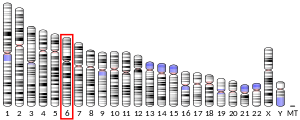NCR3
Natural cytotoxicity triggering receptor 3 is a protein that in humans is encoded by the NCR3 gene.[3][4][5] NCR3 has also been designated as CD337 (cluster of differentiation 337) and as NKp30.
References
- ENSG00000236979, ENSG00000206430, ENSG00000237808, ENSG00000236315, ENSG00000223833, ENSG00000225211, ENSG00000204475 GRCh38: Ensembl release 89: ENSG00000237103, ENSG00000236979, ENSG00000206430, ENSG00000237808, ENSG00000236315, ENSG00000223833, ENSG00000225211, ENSG00000204475 - Ensembl, May 2017
- "Human PubMed Reference:". National Center for Biotechnology Information, U.S. National Library of Medicine.
- Nalabolu SR, Shukla H, Nallur G, Parimoo S, Weissman SM (Mar 1997). "Genes in a 220-kb region spanning the TNF cluster in human MHC". Genomics. 31 (2): 215–22. doi:10.1006/geno.1996.0034. PMID 8824804.
- Sato M, Ohashi J, Tsuchiya N, Tadokoro K, Juji T, Hanaoka K, Tokunaga K, Yabe T (Jan 2002). "Identification of novel single nucleotide substitutions in the NKp30 gene expressed in human natural killer cells". Tissue Antigens. 58 (4): 255–8. doi:10.1034/j.1399-0039.2001.580406.x. PMID 11782277.
- "Entrez Gene: NCR3 natural cytotoxicity triggering receptor 3".
Further reading
- Djeu JY, Jiang K, Wei S (2002). "A view to a kill: signals triggering cytotoxicity". Clin. Cancer Res. 8 (3): 636–40. PMID 11895890.
- Holzinger I, de Baey A, Messer G, et al. (1995). "Cloning and genomic characterization of LST1: a new gene in the human TNF region". Immunogenetics. 42 (5): 315–22. doi:10.1007/BF00179392. PMID 7590964.
- de Baey A, Fellerhoff B, Maier S, et al. (1998). "Complex expression pattern of the TNF region gene LST1 through differential regulation, initiation, and alternative splicing". Genomics. 45 (3): 591–600. doi:10.1006/geno.1997.4963. PMID 9367684.
- Neville MJ, Campbell RD (1999). "A new member of the Ig superfamily and a V-ATPase G subunit are among the predicted products of novel genes close to the TNF locus in the human MHC". J. Immunol. 162 (8): 4745–54. PMID 10202016.
- Pende D, Parolini S, Pessino A, et al. (1999). "Identification and Molecular Characterization of Nkp30, a Novel Triggering Receptor Involved in Natural Cytotoxicity Mediated by Human Natural Killer Cells". J. Exp. Med. 190 (10): 1505–16. doi:10.1084/jem.190.10.1505. PMC 2195691. PMID 10562324.
- Sivakamasundari R, Raghunathan A, Zhang CY, et al. (2000). "Expression and cellular localization of the protein encoded by the 1C7 gene: a recently described component of the MHC". Immunogenetics. 51 (8–9): 723–32. doi:10.1007/s002510000192. PMID 10941844.
- Strausberg RL, Feingold EA, Grouse LH, et al. (2003). "Generation and initial analysis of more than 15,000 full-length human and mouse cDNA sequences". Proc. Natl. Acad. Sci. U.S.A. 99 (26): 16899–903. Bibcode:2002PNAS...9916899M. doi:10.1073/pnas.242603899. PMC 139241. PMID 12477932.
- Le Bouteiller P, Barakonyi A, Giustiniani J, et al. (2003). "Engagement of CD160 receptor by HLA-C is a triggering mechanism used by circulating natural killer (NK) cells to mediate cytotoxicity". Proc. Natl. Acad. Sci. U.S.A. 99 (26): 16963–8. doi:10.1073/pnas.012681099. PMC 139252. PMID 12486241.
- Augugliaro R, Parolini S, Castriconi R, et al. (2003). "Selective cross-talk among natural cytotoxicity receptors in human natural killer cells". Eur. J. Immunol. 33 (5): 1235–41. doi:10.1002/eji.200323896. PMID 12731048.
- Mungall AJ, Palmer SA, Sims SK, et al. (2003). "The DNA sequence and analysis of human chromosome 6". Nature. 425 (6960): 805–11. Bibcode:2003Natur.425..805M. doi:10.1038/nature02055. PMID 14574404.
- Marcenaro E, Augugliaro R, Falco M, et al. (2004). "CD59 is physically and functionally associated with natural cytotoxicity receptors and activates human NK cell-mediated cytotoxicity". Eur. J. Immunol. 33 (12): 3367–76. doi:10.1002/eji.200324425. PMID 14635045.
- Xie T, Rowen L, Aguado B, et al. (2004). "Analysis of the Gene-Dense Major Histocompatibility Complex Class III Region and Its Comparison to Mouse". Genome Res. 13 (12): 2621–36. doi:10.1101/gr.1736803. PMC 403804. PMID 14656967.
- Gerhard DS, Wagner L, Feingold EA, et al. (2004). "The Status, Quality, and Expansion of the NIH Full-Length cDNA Project: The Mammalian Gene Collection (MGC)". Genome Res. 14 (10B): 2121–7. doi:10.1101/gr.2596504. PMC 528928. PMID 15489334.
- Nowbakht P, Ionescu MC, Rohner A, et al. (2005). "Ligands for natural killer cell-activating receptors are expressed upon the maturation of normal myelomonocytic cells but at low levels in acute myeloid leukemias". Blood. 105 (9): 3615–22. doi:10.1182/blood-2004-07-2585. PMID 15657183.
- Poggi A, Massaro AM, Negrini S, et al. (2005). "Tumor-induced apoptosis of human IL-2-activated NK cells: role of natural cytotoxicity receptors". J. Immunol. 174 (5): 2653–60. doi:10.4049/jimmunol.174.5.2653. PMID 15728472.
- Vitale M, Della Chiesa M, Carlomagno S, et al. (2005). "NK-dependent DC maturation is mediated by TNFalpha and IFNgamma released upon engagement of the NKp30 triggering receptor". Blood. 106 (2): 566–71. doi:10.1182/blood-2004-10-4035. PMID 15784725.
- Warren HS, Jones AL, Freeman C, et al. (2005). "Evidence that the cellular ligand for the human NK cell activation receptor NKp30 is not a heparan sulfate glycosaminoglycan". J. Immunol. 175 (1): 207–12. doi:10.4049/jimmunol.175.1.207. PMID 15972650.
- Joyce MG, Gordon M, Tran P, et al. (2011). "Crystal structure of human natural cytotoxicity receptor NKp30 and identification of its ligand binding site". PNAS. 108 (15): 6223–6228. Bibcode:2011PNAS..108.6223J. doi:10.1073/pnas.1100622108. PMC 3076882. PMID 21444796.
External links
- NCR3+protein,+human at the US National Library of Medicine Medical Subject Headings (MeSH)
- PDBe-KB provides an overview of all the structure information available in the PDB for Human Natural cytotoxicity triggering receptor 3 (NCR3)
This article incorporates text from the United States National Library of Medicine, which is in the public domain.
This article is issued from Wikipedia. The text is licensed under Creative Commons - Attribution - Sharealike. Additional terms may apply for the media files.




